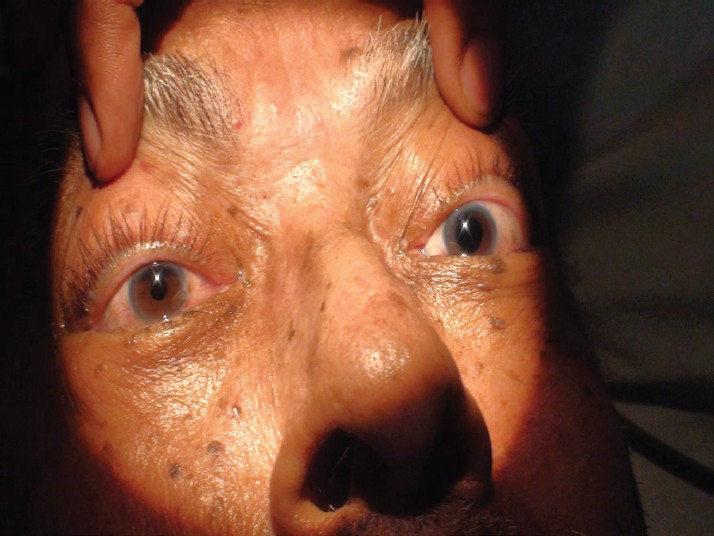Translate this page into:
Transient anisocoria: A pesky palpitation
Address for correspondence: Dr. S. SenthilKumaran, Department of Accident, Emergency and Critical Care Medicine, Sri Gokulam Hospital and Research Institute, Salem, Tamil Nadu, India. E-mail: maniansenthil@yahoo.co.in
This is an open-access article distributed under the terms of the Creative Commons Attribution-Noncommercial-Share Alike 3.0 Unported, which permits unrestricted use, distribution, and reproduction in any medium, provided the original work is properly cited.
This article was originally published by Medknow Publications and was migrated to Scientific Scholar after the change of Publisher.
Sir,
Anisocoria in an emergency room invariably indicates an impending life-threatening neurosurgical emergency. It may be the first and only sign of third nerve dysfunction from expanding aneurysm, or intracranial bleeding, cerebral neoplasm/compression, meningeal infiltration or tentorial herniation. Determining the cause of anisocoria is challenging in a critically ill patient, since the patient is often sedated, paralyzed or has an altered mental status. As clinical neurological examination is limited, the situation warrants advanced neuroradiologic investigations. Here, we report a case of anisocoria due to unintentional ocular exposure to nebulized ipratropium bromide.
A 65-year-old male with a history of severe head injury and a Glasgow Coma Score (GCS) of 7T/10T, without demonstrable changes in the initial non-contrast cerebral computer tomography (CT), was referred to our center on the second day in anticipating a neurosurgical intervention as he had dilated (7 mm), non-reacting left pupil without change in his GCS. Neurologic examination in our emergency department was essentially nonfocal with a fixed and dilated left pupil [Figure 1]. Urgent CT brain at that time did not reveal any acute or new changes. Further review disclosed that he received nebulized ipratropium bromide via a faulty nebulizer set leaking predominantly toward the left side of the face. One-tenth percent pilocarpine instilled in each eye to test cholinergic supersensitivity resulted in no pupillary constriction. One percent pilocarpine was instilled in each eye and, after 30 minutes, the right pupil constricted from 4 to 2 mm, whereas the left pupil remained dilated at 7 mm which was consistent with pharmacological cause for dilation. The patient was closely followed up. Within the next 8 hours, the anisocoria resolved and the pupil reduced to 2 mm in size and reacted normally to light. There were no subsequent episodes of anisocoria.

- Unilateral fixed dilated left pupil after inhalation of nebulized ipratropium bromide
In the absence of a structural cause, transient anisocoria in critically ill may be due to contamination of the eye from nebulized ipratropium bromide[1–7] which paralyzes parasympathetic nerve endings as reported in the literature,[8] but is still not immediately recognized. Minimal pupillary asymmetry following ocular exposure to nebulized ipratropium in clinical practice is often not noticed or considered in practice or discussed much in teaching-training. In our patient, the repeated nebulization may have resulted in an exaggerated mydriatic effect as an animal study[9] suggests that following the use of anti-cholinergic agents, the β-receptor in the eye gets stimulated and can potentiate the mydriatic effect of beta- adrenergic agents by about twofold. Failure of the dilated pupil to constrict after instillation of 1% of pilocarpine hydrochloride confirms the diagnosis[10] and alleviates the fear and prevents the need for extensive investigations.
This report highlights the necessity of doctors to consider the possibility of pharmacological causes in the differential diagnosis of anisocoria in the absence of structural lesions, before proceeding to extensive evaluation.
Dr. K. Arthanari, M. S. is acknowledged for his logistical support.
References
- Acute pupil asymmetry in a 6-month-old boy. Diagnosis: Pharmacologic anisocoria. Pediatr Ann. 2009;38:622-4.
- [Google Scholar]
- Ipratropium-bromide-induced acute anisocoria in the intensive care setting due to ill-fitting face masks. Respir Care. 2005;50:1662-4.
- [Google Scholar]
- Styrofoam cup, ipratropium bromide, and anisocoria. Clin Pediatr(Phila). 1999;38:318.
- [Google Scholar]
- Images in clinical medicine. Nebulizer-associated anisocoria. N Engl J Med. 2006;354:e8.
- [Google Scholar]
- Transient anisocoria caused by aerosolized ipratropium bromide exposure from an ill-fitting face mask. J Neuroophthalmol. 2008;28:236-7.
- [Google Scholar]
- Muscarinic blockers potentiate beta-adrenergic relaxation of bovine iris sphincter. Graefes Arch Clin Exp Ophthalmol. 2003;241:226-31.
- [Google Scholar]





